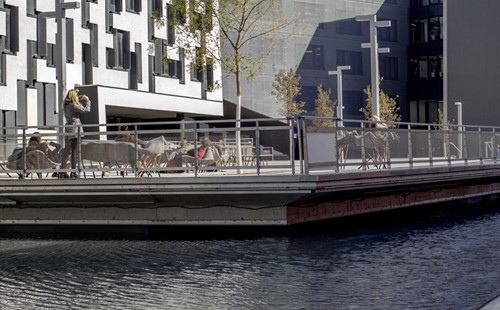About WU Vienna
The Vienna University of Economics and Business (German: Wirtschaftsuniversität Wien, WU) is a public university in Vienna, Austria, and is the largest university focusing on business and economics in Europe. It has been ranked as one of the best business schools in Europe and received Triple accreditation (AACSB, EQUIS, and AMBA).
In the current QS World University Rankings by Subject, WU is represented in six subjects in the Social Sciences & Management category. The results are based on data including employer surveys and the quality metrics for academic publications.
In the field of Business & Management Studies, WU is the only Austrian university to be ranked among the top 50 international universities, coming in at 36th place. WU also achieved placements in the subject areas Accounting and Finance (95th place), Economics & Econometrics (96th place), Social Sciences & Management (119th place), Law & Legal Studies (201–250 group), and Computer Sciences & Information Systems (401–450 group). “The results of the latest QS Subject Rankings show that WU has an excellent international reputation, both in academia and the business world. Especially our results in the Business & Management Studies category show that WU’s research and teaching is highly competitive internationally,” says Rector Edeltraud Hanappi-Egger.
About the QS Rankings
The annual World University Rankings issued by Quacquarelli Symonds (QS) are among the best-known higher education rankings worldwide, alongside the Times Higher Education (THE) ranking. In addition to the World University Rankings, QS also publishes the QS World University Rankings by Subject, which rank 15,200 degree programs taught at 1,543 universities around the world in five general disciplines (Arts and Humanities; Engineering and Technology; Life Sciences and Medicine; Natural Sciences; Social Sciences and Management). Seventeen Austrian universities are listed in this year’s subject rankings. The rankings are based on four indicators: Two types of surveys to determine universities’ reputation scores with a total of over 200,000 respondents worldwide – one survey conducted among academics and one among employers – and citation and impact scores of academic publications.
History
1898 Founded as the Imperial Export Academy, located in Vienna’s Palais Festetics
1919 Becomes the state-run University of World Trade
1938 Austria’s “Anschluss” to Nazi Germany had far-reaching consequences (students and faculty expelled/stripped of their academic degrees)
1948 Degree programs include Global Trade, Business Administration, Economics, and Business Education
1975 The University is restructured and receives the name Wirtschaftsuniversität Wien
2004 The Universities Act (UG 2002) grants autonomy to Austria’s universities
2006 Starts to implement the Bologna system in its degree programs
2007 WU is granted the EQUIS accreditation, an important seal of excellence
2013 Move to the new Campus WU on Welthandelsplatz
2014 With its AACSB accreditation, WU becomes the first Austrian university to hold triple accreditation (from AACSB, EQUIS, and AMBA)
2018 Launched first English-taught Bachelor’s Program in Business and Economics in Austria
2019 Campus WU climate neutral in operation
2020 25 new professors hired, as negotiated in the 2019-2021 Performance Agreement

© Copyright WU Wien
WU today
Today, WU has more than 20,000 students and over 400 researchers and lecturers, among those about 90 full professors. It increasingly draws students from outside Austria, mostly from Central and Eastern Europe. Most of the faculty are of Austrian or German nationality.
New campus
The new location is dubbed "Campus WU" and had its groundbreaking ceremony in October 2009. Close to the Prater public park, and next to the exhibition centre of Vienna, the campus features 6 main building complexes resting on approximately 25 acres (10 ha). The master plan was created by BUSarchitektur under the guidance of the architect Laura P. Spinadel. Architectural firms from Spain, the United Kingdom, Germany, Japan and Austria designed the buildings of the campus. The dominant element of the campus is the Library & Learning Center, which was planned by Zaha Hadid.
Construction began in June 2010 and paved the way for the largest campus for business sciences in Europe. With a total investment of 492 million Euros and a planned construction period of 3 years, the project was concluded in 2013. Campus WU is situated close to the public transport hub Praterstern and is serviced by two stations of the underground line U2 and a number of buses.
The LC has five cores, each with a different complex geometry. The core walls are inclined at different angles and so are the corners which are also rounded with different radii. MEVA has developed and uses both standard and special formwork, or a combination of both, to meet the forming requirements for these complex building parts. Steel formwork, for example, is used for rounded corners if required for structural reasons. Trapezoidal areas of inclined cylindrical corner areas are poured with special Mammut 350 wall formwork panels and special designs of MEVA’s circular column formwork Circo are used for the tilted and rounded corners.
Research
Researchers at WU work in the following fields:
Business Administration and all its branches Economics
Law
Linguistics, focus on Business Communication Socioeconomics
Mathematics and Statistics
Economic History and Economic Geography
With students in Austria being free to choose at which university they enroll, WU has become the most popular business and economics university in Vienna and in Austria.








